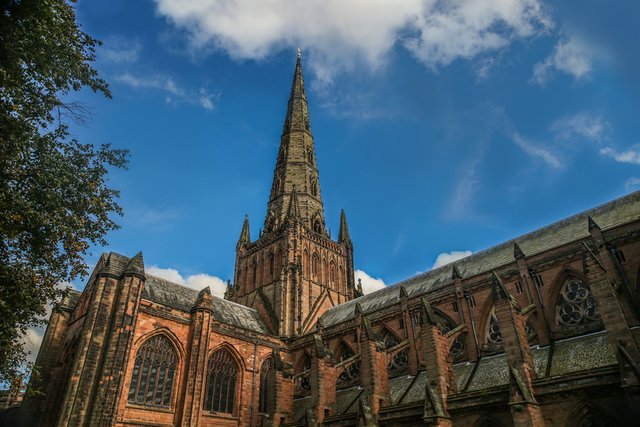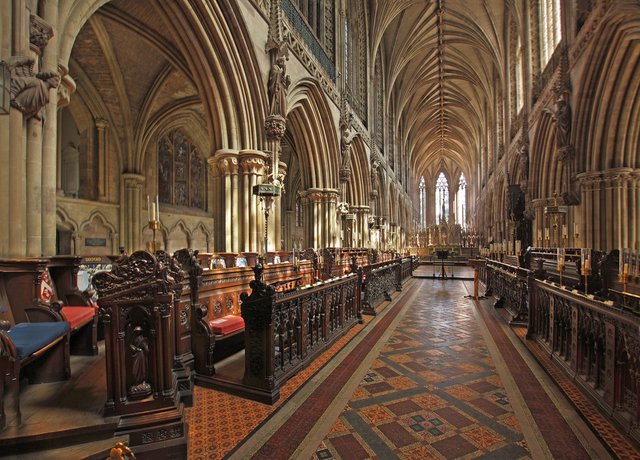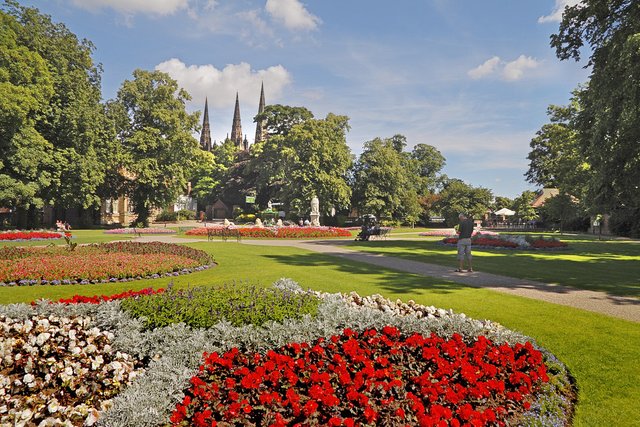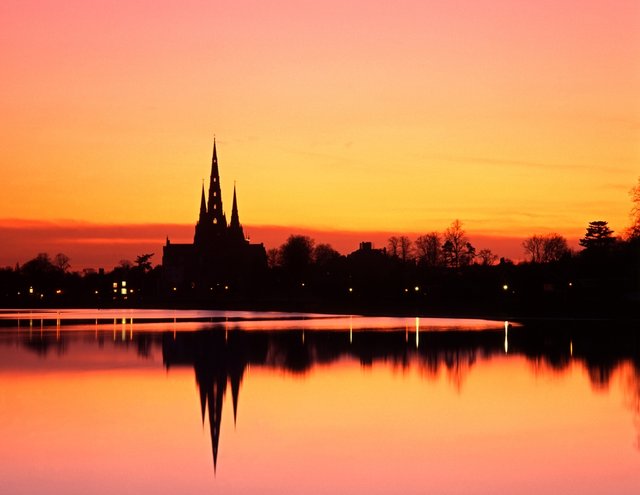A visit to Lichfield - The cathedral city in Staffordshire, England

If I had to make a list of Britain’s prettiest places, Lichfield’s Cathedral Close would be near the top. To our untrained eyes, the attractive array of buildings show no signs of their Civil War battering. Back then, the cathedral authorities supported the King and its siege left the close and cathedral severely damaged.
Divine intervention was suggested when Robert Greville, the roundhead leading the assault, was killed by a deflected shot – on St Chad’s Day. When St Chad became Bishop of Mercia in 669 he moved to Lichfield and the church built to protect his bones grew to become the cathedral.
The spot became a pilgrimage site, leaving a unique literary legacy – the Lichfield Gospels. This ancient illuminated text is just one historic marvel on display in the Chapter House, whose beautiful vaulted roof isn’t quite as solid as it seems. In 2016 a £2 million appeal was started to stabilise the ceiling.
Other Chapter House cabinets hold a few fragments of the county’s famous gold hoard, discovered nearby in 2009, and a unique broken stone panel depicting an angel, which itself was unearthed a few years earlier. Work on the new altar revealed three sculpted stone fragments decorated with an angel – possibly part of St Chad’s shrine chest.
Inside and out, the cathedral has so much to see, from the ancient glass around the Lady Chapel to the small chapel where, up until the early 1500s, the head of the saint was displayed . . . until it mysteriously disappeared. Outside, the front is decorated with 113 statues of biblical figures, saints and monarchs, but you will need a pair of binoculars and giraffe-like neck to appreciate them all.
At Minster Pool we paused to chat with a lady. “I love it that I can walk this way to work. Even in winter it is beautiful,” she said, looking across the water to the cathedral’s three spires rising above the trees.
Lincoln’s cathedral once also boasted three spires, but one collapsed in the mid-1500s, leaving Lichfield as Britain’s oldest with this feature. An old coaching town, it has a number of historic hotels as well as more modern places to stay.

Bird Street is dominated by the Swan and, over the road, the George, both of which once provided hospitality to coach passengers. The George played its part in Louis Paulhan’s recordbreaking flight in 1910 from London to Manchester. The Frenchman landed his plane outside the city, staying overnight in the hotel, before continuing north the next morning.
His part in history had a successful outcome, unlike Edward Smith’s. Born in Stoke, his statue stands in Museum Gardens, perhaps remembering his command of the White Star vessels Majestic, Baltic, Adriatic and Olympic, before finally taking command of the Titanic. On the opposite side of the old town we found another sylvan delight within St John’s Hospital grounds.
Bernard Derrick noticed me taking a picture of this unique set of almshouses and waved us in. He lives in one of the oldest dwellings attached to the ancient chapel and was delighted to point out one of the city’s newest places to live.
In 1758, Lichfield was almost the starting point of Britain’s canal network. Local engineer James Brindley was asked to make the city the hub of a national canal system, but his plans weren’t realised. It was another 40 years before the Wyrley & Essington canal extension joined the town almost as an afterthought.
A few years after it was opened, the canal was used to carry the ancient glass windows from Herkenrode Abbey in Flanders that we had admired in the cathedral. For most of its life, barges carried coal, lime, manure and grain for brewing – hopefully not in the same boat. In the 1700s, one of Britain’s well-known figures,
Dr Samuel Johnson, best remembered as creator of his epic dictionary, lived the first 27 years of his life in a market-place house here. After a bit of teaching, with the famous actor David Garrick his first pupil, they left the city together in 1737.
Dr Johnson’s birthplace is a very interesting free museum, but being an old building there are quite a few steep steps. Visitors with problems climbing these can enjoy a “virtual” tour on the ground floor, but we made it to the top floor, where we found a display of his possessions, including his punch bowl and shoe buckles, beside a copy of his famous dictionary.

Although the writer experienced severe poverty, in his latter years he enjoyed a pension of £300 a year given by the King “for Services to Literature”. Of course, we know so much about his life courtesy of his friend James Boswell, whose statue stands near his literary chum in the square.
When the congregation of St Mary’s dwindled, the space was shared with the local tourist information centre, museum and a café, which is popular with shoppers. A small space for worship has been retained at the altar, and during the rest of the week visitors can find out more about this historic city upstairs, where very well done displays explore every aspect of Lichfield’s past.
If you visit when a volunteer is available, you can risk vertigo by climbing the winding spiral stairs to enjoy an elevated view from the spire, or like us, take time to enjoy Sylvia Everitt’s superb tapestry panels, which took more than five years to stitch in time for the millennium. Pausing where Breadmarket Street reaches Bore Street, a panoramic architectural display reflects the city’s heritage.
The oldest is the stone Guildhall, which in the past has served as council office, court, jail and even a fire station. A 16th-century timberframed house jetties out over the street, followed a century or so later by the black and white delight of Five Gables.
Donegal House signals the Georgian era and, finally, the 2003 Garrick Theatre is the most recent landmark. If you are looking for an antidote to the big high street names, Tamworth Street is a lovely little shopping lane, filled with quirky individual places like the Spellbound Bead Company, which caught Hazel’s eye.

On our way back to the car we wandered through a fragrant herb garden to visit the home of Erasmus Darwin. Grandfather of the famous scientist Charles, he lived in a prominent house at the end of Cathedral Close and was a member of the Lunar Society, which included other innovators and free-thinkers such as Josiah Wedgwood.
The two families grew closer when Erasmus’s son married a Wedgwood, as did his “Origin Of The Species” grandson. I wonder If they got a discount on their pottery purchases. Erasmus was a very clever chap, inventing all manner of things like a vertical windmill, canal lift for barges, copying machine and carriage-steering mechanism which is still used today. We are all grateful for one of his innovations. Concerned at the general unpleasantness of 18th-century plumbing, he devised a flushing toilet!
When you come, allow sufficient time. It would be easy to spend a whole day within the confines of the Close, yet this charming city has so much to offer.
P.S. All the travels posted by me are imaginary but the historical facts are true :)
Follow for more...
Congratulations @gcyrogy! You have completed some achievement on Steemit and have been rewarded with new badge(s) :
Click on any badge to view your own Board of Honnor on SteemitBoard.
For more information about SteemitBoard, click here
If you no longer want to receive notifications, reply to this comment with the word
STOPBy upvoting this notification, you can help all Steemit users. Learn how here!
You have a very interesting post. I see you are interested in history. When you follow the link, you will learn a little history of Kievan Rus https://steemit.com/travel/@hajevoy60/unique-seal-of-prince-svyatoslav-in-the-church-of-the-golden-gate-10th-century